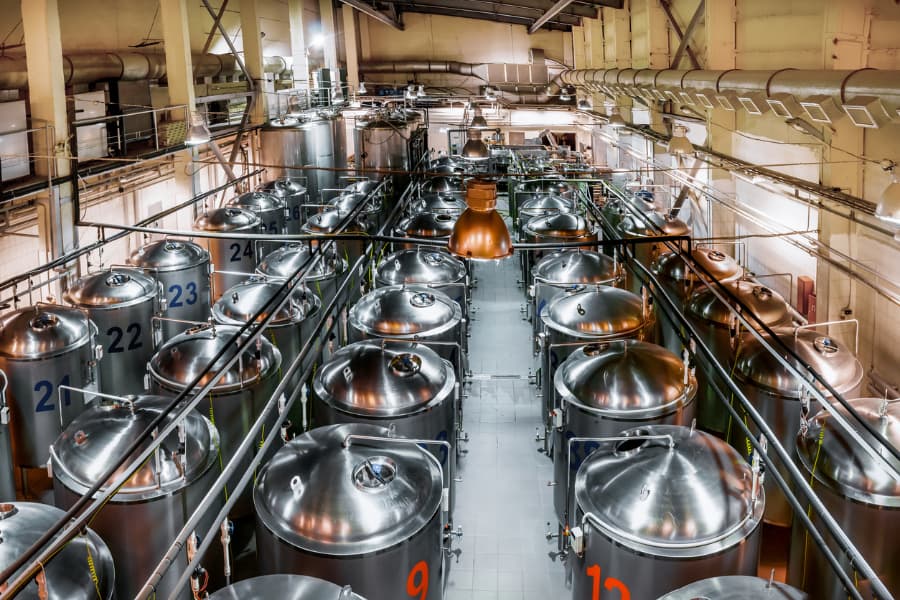
A lager is a style of beer that, compared to traditional brewing, is made with a longer fermentation process at a lower temperature. This requires more storage time, which means the overhead costs of producing a fine lager are higher than those of an ordinary beer. Ales also rank as specific types of beer. The technical differences between these products relate to the brewing process. Brewing lagers requires a longer fermentation period, and that fermentation occurs from the bottom up to the top. Regular beer and ales ferment at higher temperatures from the top down.
As the brewing of lagers requires specific temperature control over extended periods, mechanical process equipment plays a pivotal role in ensuring precision and consistency throughout the production cycle. From fermentation tanks to cooling systems, each piece of equipment must function optimally to maintain the ideal conditions for lager production. Any deviation in temperature or timing can compromise the quality of the beer, highlighting the need for reliable, efficient equipment.
Companies like Flexachem provide specialized solutions to support breweries, offering cutting-edge technologies and expert technical support to help producers meet both production demands and regulatory standards. Their technical support extends beyond just equipment supply; it includes installation, maintenance, and troubleshooting, providing breweries with the tools and expertise necessary for smooth operations and consistent product quality, all while meeting the evolving demands of the brewing industry.
At Columbia Distributing, we sell all types of beers and other alcoholic and non-alcoholic beverages that cover the rapidly growing industry. Oregon, Washington, and California lead most of the beverage trends in the United States, including craft beers, fermented drinks that boost health, the bubble tea craze, canned cocktails, alcohol-free beer, and other drinking trends. We support multicultural backgrounds and beliefs as a signature part of our services, which means we stock a wide variety of beverages for all races, ethnicities, and nationalities.
Appreciating the Fine Differences Between Beer Types
There are no major differences between beer, lager, and ale. The differences come in the fine flavor details. Beer choices today encompass an astonishing range of products, including imports and craft beers. You can find beers with a sour flavor, pilsners with complex flavor notes, and a dizzying array of draft beers at your favorite local watering holes. Pilsners are the Czech name for lager-types of beer, and they rank among the most popular.
Yeast Adds Flavor Complexities to Beer
The basic differences in beer come down to the type of yeast used in the fermentation process. Yeast types produce their own subtle differences in flavor, which is demonstrated by the awe and reverence given to certain sourdough starters. Ales ferment from the top down, and pilsners ferment from the bottom up. Ales ferment at warmer temperatures quickly while pilsners and lagers ferment slowly for longer times, which many aficionados claim adds deeper flavor. In foreign countries, ordering a beer might result in being served an ale or a pilsner.
Germany Establishes Historic Standards for Beer
Beer has been brewed for many centuries, and the most significant development occurred in the 1500s. At that time, Germany established standards that remain in place today for traditional beer brewers. The crux of the brewing standard limits beer manufacturing to four ingredients: water, malted wheat, malted barley, and hops. At the time when Germany established the “Reinheitsgebot” to guarantee the purity of German beer, the microscope hadn’t yet been invented. Yeast hadn’t been identified or explained, so that makes a fifth mandatory ingredient in any type of beer.
Today, modern brewing facilities have evolved far beyond the traditional methods of the past, incorporating state-of-the-art equipment and process automation to ensure efficiency, consistency, and quality in every batch. While the core ingredients remain the same, advanced brewing systems now include automated fermentation controls, precision temperature regulation, and high-efficiency filtration systems that optimize production. Byers Industrial Services plays a crucial role in this evolution, offering industrial equipment installations tailored to breweries looking to streamline their operations.
From the installation of stainless steel process piping to integrating fully automated brewing and packaging lines, these advancements allow breweries to maintain the integrity of traditional brewing while maximizing output and reducing waste. Whether it’s a craft brewery looking to scale up production or a large facility implementing high-speed bottling systems, the combination of modern technology and expert industrial services ensures that beer continues to be brewed with both artistry and precision.
Flavor Profile of Lagers
Most lagers have lighter, more delicate flavor because the alcohol builds up during the longer fermentation process, which slows alcohol conversion rates. However, that doesn’t mean you won’t detect other subtle flavors like malt, hoppy flavors, subtle bitterness, and even funkier sour flavors. The craft beer trend has resulted in a variety of flavors with lagers to suit any taste.
The skyrocketing increase in craft beers merely reflects European trends that have been followed for centuries. European brewers always produced signature beers for their customers, and Americans finally caught up with Europe with the craft beer movement. At Columbia Distributing, we make it easy to find and order craft beers that include pilsners and lagers. Check out our full list of alcoholic and non-alcoholic beverages for your specific state.
Order Lager and Other Beers Today
At Columbia Distributing, we’re always excited to share information and educate people about beers and other beverages. Reach out to us for more information or to place a beverage order in Oregon, Washington, or California. We also feature a retailer portal to make handling your wholesale account easier for a greater customer experience. You can review your account history, find products you previously ordered, find customized links for seasonal recommendations, and manage your product searches more efficiently.